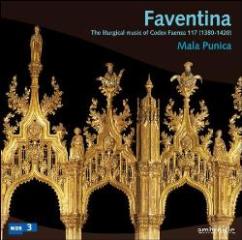Mala Punica - Faventina. Música litúrgica del Codex Faenza 117 (2005)
Mala Punica - Faventina. Música litúrgica del Codex Faenza 117 (2005)

Ordinarium missae 1.Kyrie Cunctipotentes genitor Deus (Fa 117, ff. 79r-79v) 2.Kyrie Cunctipotentes genitor Deus (Fa 117, ff. 88r-90r) 3.Gloria (Fa 117, ff. 90r-92v) 4.Kyrie Fons et origo (Fa 117, ff. 2r-3r) 5.Alleluja Ego sum pastor bonus (I-Gua, f. 194v) 6.Kyrie Orbis factor (Fa 117, ff. 62r-26r) Cantasi come 7.Nostra avocata sei, cantasi come Deduto sei (Vat266, f. 32v; ff. 46v-48r) 8.Per verità portare. Cantasi si come Non al suo amante (I-Ricc2871, f. 59v) 9.Non al suo amante (Fa 117, ff. 78r-79r) Ad vesperas 10.[Deus im adjutorium meum intende] (Fa 117, ff. 93r-94r) 11.Antiphona: Hec est regina (I-SM572, f. 141r); psalmus: Laudate pueri Dominum 12.Ave Maris stella (Fa 117, ff. 96v-97r) 13.Antiphona: Ave regina celorum (I-SM574. Ff. 109v-110r) 14.Magnificat (Fa 117, ff. 955-96v) 15.Sicut erat in principio, cantasi come [Soventt mes pas] (Fa 117, f. 94v) 16.Benedicamus Domino, Deo gratias (Fa 117, ff. 79r-79v) 17.Benedicamus Domino (Fa 117, ff. 79r-79v) 18.Benedicamus Domino (Fa 117, ff. 57r-58r) Mala Punica: Tina Aagard (soprano), Barbara Zanichelli (soprano), Alessandro Carmignani (counter-tenor), Gianluca Ferrarini (tenor), Raffaele Giordani (tenor), Juan Sancho (tenor), Pablo Kornfeld (organ, clavicymbalum), Guillermo Pérez (organetto), David Catalunya (organ, clavicymbalum), Helena Zemanová (fiddle), Angélique Mauillon (harp), Pedro Memelsdorff (recorder) Pedro Memelsdorff – conductor The liturgical music of Codex Faenza 117 (1380-1420).
The Codex Faenza 117 in the Bibloteca Communale Manfredina is the oldest complete surviving manuscript of instrumental music in the world, started by a single scribe around 1380, but heavily recompiled between 1400 and 1420. In the early 1470s, yet another scribe scraped some of its pages clean and added yet more music, creating a "palimpsest"; a manuscript that has been recycled, yet contains traces of the information that went down before. A similar palimpsest containing otherwise unknown writings of ancient Greek inventor Archimedes elicited a great deal of public interest in the early twenty-first century, and it might surprise some readers that a similar situation exists in regard to certain medieval music manuscripts. In the case of the Codex Faenza, the erased sections represent music in an older style of intabulation than that shown in the replacements. While X-ray technology may reveal the intabulations, it takes scholars and musicians to transfer that information back into something that brings to life such historically distant music. Venetian early music group Mala Punica, led by Pedro Memelsdorff, presents on this Ambroisie release entitled Faventina all of the liturgical music from Codex Faenza 117, including the erased sections from the palimpsest not previously known. Although Codex Faenza has supplied pieces for many recorded collections of medieval music, some devoted only to its content, these have been heavily concentrated towards the many secular pieces in the manuscript -- the sacred ones are not nearly as familiar.
As the manuscript is overwhelmingly instrumental, texts had to be reclaimed through locating the same pieces in other sources, a long list of which are duly presented at the end of the track listing in the booklet. This package is responsible down to the smallest detail in providing direct access to the data to understanding what we are hearing down to listing the manuscript folio numbers for specific pages played; an admirable quality. Mala Punica also used the clavicymbalum, a medieval ancestor to the harpsichord that enjoys a tone quality not dissimilar to that of the Hungarian cimbalom, though it is hardly a common instrument even among early music ensembles owing to a total lack of extant museum instruments; the two in use here were rebuilt from designs drawn up in the 1480s. The location of recording is not provided; it sounds like it was made in a cathedral, but may be a studio date with artificial reverberation used. Sometimes the reverb is a bit too much, swallowing instruments and voices alike. However, when the voices and instruments are combined in some pieces, such as in the Deus in adjutorum, the ensemble sound is remarkably full. The manuscript contains a lot of music that is remarkably free and varied in its approach to rhythm, ranging from dance-like figures to elaborate, loose, and ethereal passages.
Faventina seems like a new chapter in the interpretation of late medieval music, folding the free-ranging vocal style associated with earlier music along into the snappy rhythmic patterns familiar from what little instrumental music we have from the fourteenth century. While Faventina is a little inconsistent, the best pieces, such as the Magnificat setting, are both revelatory in terms of period performance and splendid delights to enjoy. Pedro Memelsdorff and Mala Punica are to be congratulated for putting this music back on the page, and into our ears, for the first time in six centuries of invisibility. --- Uncle Dave Lewis, Rovi
download: uploaded yandex 4shared mediafire solidfiles mega filecloudio nornar ziddu
Last Updated (Friday, 04 April 2014 11:42)








